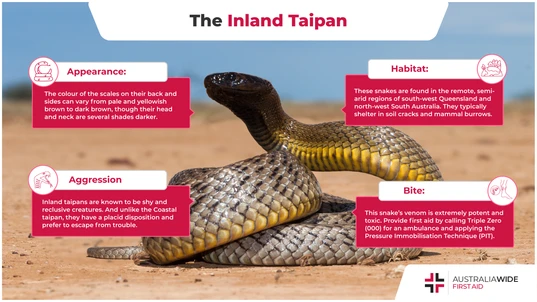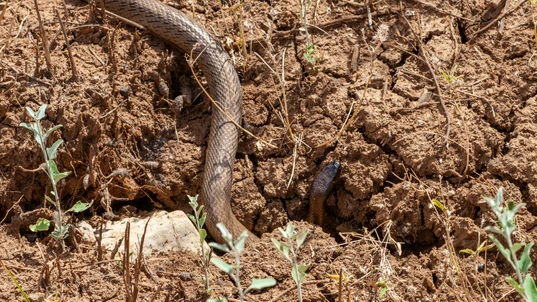Snake Facts: The Taipan

Bites and Stings

There are two types of Taipans found in Australia: the Inland taipan and the Coastal taipan. Due to their aggressive nature and toxic venom, these snakes are considered some of the most dangerous in the world.
The Taipan is cited as one of the most dangerous snakes in Australia and around the world due to their aggressive behaviour and highly toxic bites. There are two types of taipans found in Australia, namely, the Inland taipan and Coastal taipan. Both are known to be endemic to Australia and are listed within the top 5 most toxic snakes in the world.What are Taipans?
Taipans are part of the Elapidae family first described by Wilhelm Peters in 1867. However, due to the rarity of Taipans, it wasn’t until the 1960s that these snakes began to be studied more closely by the scientific community. Inland taipans are primarily found in arid desert regions of Australia, mainly south-western Queensland and north-eastern South Australia. Coastal taipans, on the other hand, are mainly found along the north-eastern coasts of New South Wales, all the way through to Queensland and across the northern parts of the Northern Territory. Taipan bites are nearly always fatal, as a bite from one of these snakes is strong enough to kill 100 adult humans or 25,000 mice. Their venom is the most toxic out of any snake. It is also considered the most dangerous out of any reptile when tested on a human heart cell culture. This evolutionary trait makes it a specialist hunter adapted to kill warm-blooded species. Taipans are egg layers and during breeding season, they will lay anywhere between 7 – 20 eggs at a time, which take roughly 64 – 68 days to hatch. Studies have shown that Taipans observe mating season during the late winter season from late August until the middle of November. Young taipans are fully equipped to hunt shortly after hatching from their eggs and can reach a full metre in their first year.Identifying a Taipan
Taipans are quite unique in their appearance and identifiers. In this section of the article, we’ll make a distinction between Inland taipans and Coastal taipans due to the significant danger these two species pose to humans.Inland Taipan
For Inland taipans, here are some common identifiers unique to these snakes:- Medium to large snake with a robust build that can grow up to 1.7 metres in length
- Deep, rectangular-shaped head
- Dorsal colour (the colour of the scales on the body of the snake) can vary from pale and yellowish-brown to dark brown – the head and neck are typically several shades darker than the body. The scales on their belly, meanwhile, tend to be creamy or yellow in colour
- The colour of their scales changes seasonally, which generally become darker in winter and lighter in summer
- Eyes are typically large with dark irises and round pupils
Coastal Taipan
For Coastal taipans, here are some common identifiers unique to this snake:- Medium to large snake with a robust build and slender neck that can grow up to 2.9 metres in length
- Deep, rectangular-shaped head
- The are usually a uniform light to dark brown in colour, though they can sometimes almost be black in colour. Their underside, meanwhile, is usually creamy or yellow in colour
- The colour of their scales changes seasonally, which generally become darker in winter and lighter in summer
- The head is noticeably paler than the body
- Eyes are typically large with intense orange-brown irises and round pupils

Inland taipans (like the one pictured above) are mostly found in remote, semi-arid regions in Queensland and South Australia. Due to the lack of vegetation, Inland taipans typically shelter in soil cracks, crevices, and mammal burrows.
Taipans and Their Hunting Habits
Inland taipans are solitary and diurnal (daytime) creatures. As they are mainly found in arid parts of the country and among the grasslands, these snakes spend most of the morning basking in the sun and foraging before spending the rest of the day in shelters. Inland taipans are known to be quite shy and reclusive snakes, as they prefer to remain out of trouble. They mainly feed on small to medium-sized mammals such as rats and desert marsupials. Inland taipans hunt by cornering their prey in a burrow or soil crack before quickly striking with their venomous bite. The potency of the venom is so high that the Inland taipan can afford to hold onto its prey while waiting for it to die. Similarly, Coastal taipans are solitary and diurnal creatures, as they are most active during the day and early evening. These snakes prefer warm and wet temperate climates and can be found in tropical coastal regions. They are often found in monsoon forests, wet woodlands, and in areas with high rat and mice populations. They typically shelter in abandoned animal burrows, hollow logs, and in piles of vegetation while waiting for prey – specifically, mice, rats, bandicoots, and birds. When hunting, the Coastal taipan will hurl itself forward and strike with a lightning-fast bite before releasing its prey and allowing it to stagger away. That way, they can avoid injury from retaliation. The Coastal taipan will then track down the dying prey as its entire body succumbs to the venom.
Coastal taipans (like the one pictured above) tend to be uniformly light or dark brown in colour. Unlike their Inland counterpart, Coastal taipans are extremely nervous and will adopt a striking stance when threatened.
Are Taipans Dangerous to Humans?
Due to their venomous bites, these snakes are lethal to humans. However, Inland taipans are rarely encountered due to their remoteness and the fact that they hang above ground during the day – this allows humans to avoid them on sight. Coastal taipans, meanwhile, can be more difficult to spot in the wild, due to their habit of remaining underground and in grassy areas. What’s more, they are extremely nervous snakes, and any movement nearby will trigger an attack. A bite from either of these snakes is lethal, and the venom can cause a myriad of painful symptoms as it spreads through the bloodstream. Due to the potency and high spreading action of their venom, a bite from one of these Taipans is potentially life-threatening. To that end, anyone suspected of receiving a bite from a Taipan should seek immediate medical attention. Examples of possible symptoms include:- Headache
- Nausea
- Vomiting
- Abdominal pain
- Collapse
- Muscular paralysis
First Aid for Taipan Bite
At the time of writing, only several people have ever been bitten by a Taipan and most have survived due to the quick application of first aid and hospital treatment. The fatality of a Taipan bite can be significantly reduced by performing the following first aid procedure:- Keep the casualty at rest and as still as possible to stop the venom from travelling through the body.
- Constantly observe and reassure the casualty.
- Follow DRSABCD and be prepared to perform CPR
- Apply the ‘pressure immobilisation technique’ (PIT):
If the bite site is on a limb, cover it with a wide heavy elastic bandage (10 - 15 cm wide).
Ensure the bandage is firm and tight, so tight you cannot easily slide a finger between the bandage and the skin.
Apply a second heavy elastic bandage. Start from the fingers or toes and wind up the limb as far as possible. Consistent coverage (overlapping half over half) and consistent pressure (firm but not cutting off circulation) are key to an effective PIT. - Immobilise the limb and joints with a splint, or use a sling if the bite site is on an arm. Keep the limb immobilised until the ambulance arrives.
Taipan Bites and Anaphylaxis
Some people can have a severe allergic reaction when bitten by a snake. This is called anaphylaxis, a condition that can be fatal in as little as 15 minutes. Symptoms include:- Tightness of the throat from swelling.
- Difficulty breathing.
- Tongue and facial swelling.
- Hoarse voice or difficulty speaking.
- A wheeze or persistent cough.
- Collapse or falling unconscious.
- Becoming pale or floppy (young children).
- Abdominal pain and vomiting.
- Hives, welts, and body redness.
Final Thoughts
As one of the most venomous snakes in the world, Taipans are a force to be reckoned with. While they are rarely seen and difficult to encounter, it’s advised to take caution when treading through Taipan habitat. To learn more about the Taipan and how to treat various snake bites, book a First Aid course with Australia Wide First Aid today.
Originally published at
https://www.australiawidefirstaid.com.au/resources/taipan
as part of the Australia Wide First Aid Articles Library









